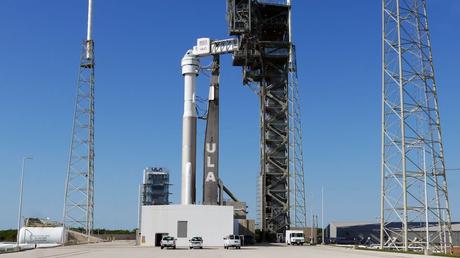After multiple delays, the long-awaited inaugural crewed launch of Boeing's Starliner is ready for liftoff on Saturday - and the new spacecraft will carry a duo of experienced astronauts.
Boeing's Crew Flight Test mission is scheduled to launch at 12:25 p.m. ET from the Cape Canaveral Space Force Station in Florida. If all goes according to plan, the mission will take NASA's Butch Wilmore and Suni Williams to the International Space Station. After eight days, they return to Earth in the reusable crew capsule and land at a location in the southwestern United States.
The launch will be streamed live on NASA's website on Saturday, with coverage beginning at 8:15 a.m. ET.
If the spacecraft does not lift off as planned atop an Atlas V rocket, backup options are available on June 2, June 5 and June 6, according to NASA.
Williams and Wilmore were aboard the Starliner on May 6, just about two hours after a historic launch, when engineers discovered a problem with a valve on the second stage, or upper portion, of the Atlas V rocket. The entire stack, including the rocket and spacecraft, was then rolled back from the launch pad for testing and repairs.
Subsequently, mission teams reported a small helium leak in the spacecraft's service module. The leak was traced to a part called a flange on a single reaction control system thruster, where helium is used to fire the thrusters and propel the spacecraft.
The space agency said the leak does not pose a threat to a mission, but while evaluating the problem, engineers also discovered a "design vulnerability" in the propulsion system - essentially identifying a remote scenario in which certain thrusters could fail while the vehicle was taking off. Earth's orbit, without a backup method to get home safely.

NASA and Boeing have since worked with the thruster vendor to come up with a backup way to perform the deorbit burn, should that situation arise, Steve Stich, manager of NASA's Commercial Crew Program, said at a 24 news conference May.
Following a flight readiness review meeting on May 29, leaders from NASA, Boeing and United Launch Alliance (which built the rocket) "verified launch readiness, including all systems, facilities and teams supporting the test flight," NASA said.
Williams and Wilmore, who remained in a standard crew quarantine to protect their health ahead of the launch attempt, returned to Houston on May 10 to spend time with their families, according to Boeing. While there, the astronauts also practiced for their flight in Starliner simulators, according to NASA.
The duo returned to NASA's Kennedy Space Center on May 28 and continued their quarantine in the Neil A. Armstrong Operations and Checkout Building prior to launch.
Suni Williams: Already in the history books
Saturday's Starliner launch would mark only the sixth maiden voyage of a manned spacecraft in U.S. history, NASA Administrator Bill Nelson noted during a news conference earlier this month.
"It started with Mercury, then Gemini, then Apollo, the space shuttle, then (SpaceX's) Dragon - and now Starliner," he said.
For Starliner's debut launch, NASA is keeping with a long tradition of crewing the new spacecraft with astronauts who previously trained as military test pilots and spent hours flying experimental aircraft.
"They're looking at a lot of the systems: the life support, the manual controls," NASA chief Bill Nelson said at a May 3 news conference. "That's why we put two test pilots on board - and of course the CVs of Butch and Suni have been expanded."
Williams, selected as a NASA astronaut in 1998, will also make history as the first woman to embark on such a mission. And it won't be her first entry in the history books.
In 2012, during an earlier trip to the International Space Station, Williams became the first person to complete a triathlon in space, simulating swimming with a weightlifting machine and running on a treadmill while strapped to a harness so she wouldn't able to swim. don't float away.
That came after she ran the Boston Marathon from the space station in 2007.
Williams - a native of Needham, Massachusetts - has also spent a lot of time off the space station.
During her previous missions, she completed seven spacewalks in a total of 50 hours and 40 minutes, ranking second among female astronauts.
Before this mission, Williams told reporters she wasn't nervous about the jump from test pilot to spacecraft.
"I don't necessarily think it's jitters," she said. "I just think it's more like last-minute checks: connecting the dots."
Williams has traveled to space twice before, once on a NASA space shuttle in 2006 and again on a Russian Soyuz capsule in 2012. She has logged a total of 322 days in space.
Wilmore: 'You can try anything'
Meanwhile, Wilmore, a test pilot from Tennessee and in the Navy, has spent more than 8,000 hours of his life aboard tactical aircraft, according to NASA.
Before being selected for NASA's astronaut corps in 2000, Wilmore was on exchange as a flight test instructor at the Air Force Test Pilot School in California.
As an astronaut, Wilmore has already spent 178 days in space on two separate missions and completed four spacewalks.
Wilmore once talked about a spacewalk while giving an acceptance speech for the NCAA Theodore Roosevelt Award in 2018. (Wilmore played football at Tennessee Technological University as an undergraduate.)
He said that during the spacewalk he was surprised to discover that a radiator on the outside of the space station was reflective, like a mirror.
"Suddenly I see myself in a spacesuit from head to toe for the first time. ... I looked back at that man and said, 'How did you get here?'" Wilmore said. "If you have a heartbeat, that's all it takes. You can try to do anything you want to do."
For more CNN news and newsletters, create an account at CNN.com
